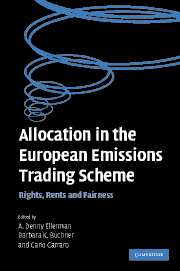Book contents
- Frontmatter
- Contents
- List of figures
- List of boxes
- List of tables
- List of contributors
- Introductory note/Foreword
- Acknowledgements
- Glossary and abbreviations
- Part I The EU ETS allocation process
- Part II Experiences from Member States in allocating allowances
- 3 United Kingdom
- 4 Germany
- 5 Denmark
- 6 Sweden
- 7 lreland
- 8 Spain
- 9 Italy
- 10 Hungary
- 11 Czech Republic
- 12 Poland
- Part III Concluding remarks and background material
- Appendix I Participants
- Appendix II The individual country outlines
- Appendix III The country tables
- Appendix IV Background material from the European Commission
- Index
7 - lreland
Published online by Cambridge University Press: 22 September 2009
- Frontmatter
- Contents
- List of figures
- List of boxes
- List of tables
- List of contributors
- Introductory note/Foreword
- Acknowledgements
- Glossary and abbreviations
- Part I The EU ETS allocation process
- Part II Experiences from Member States in allocating allowances
- 3 United Kingdom
- 4 Germany
- 5 Denmark
- 6 Sweden
- 7 lreland
- 8 Spain
- 9 Italy
- 10 Hungary
- 11 Czech Republic
- 12 Poland
- Part III Concluding remarks and background material
- Appendix I Participants
- Appendix II The individual country outlines
- Appendix III The country tables
- Appendix IV Background material from the European Commission
- Index
Summary
Introduction
Background
Economic growth
Ireland's economic growth over the past decade has been well documented; however, it is worth restating the key facts here to provide background to the challenges faced by Irish policy-makers in general and the context in which allocation decisions were being made. As 1990 is the Kyoto base year and 2001 and 2002 were the latest years for which data were available during the decision-making process on the Irish National Allocation Plan (NAP) these are the years that will be most often cited throughout this chapter.
Ireland's gross domestic product more that doubled between 1990 and 2002
The index of industrial production in 2002 was almost four times that of 1990
Electrical output increased by 67%
Unemployment has fallen by a factor of four since 1993 (16% to 4%).
Emissions profile
Driven by the high rate of economic growth Ireland's reported emissions in 2001 were 31% above the 1990 level, and while the EU15 committed itself to a reduction of 8% below the 1990 level under the Kyoto Protocol, the individual target for Ireland, as agreed under the EU's Burden Sharing Agreement (BSA), was a limitation in emissions growth to 13% above 1990.
- Type
- Chapter
- Information
- Allocation in the European Emissions Trading SchemeRights, Rents and Fairness, pp. 157 - 181Publisher: Cambridge University PressPrint publication year: 2007

